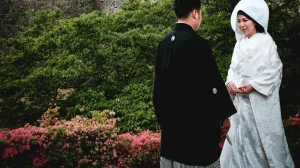As Wedding Know How editors, we write about things that we love and we think you'll like too. We have affiliate partnerships and sponsorship and may generate some revenue from these at no cost to you.
Nose rings are the second most popular type of piercing in the Western fashion scene, with an increasing number of men and women opting to have their noses pierced. Here, this piece of jewelry is still just a fashion accessory, albeit a daring one.
However, in many other parts of the world, the nose ring holds deep cultural significance, much like a wedding ring does in the West. From Indian brides to African grooms, let’s take a look at this ancient practice of wearing nose rings.
The History of Nose Rings

For as long as humans have existed, they have found ways to adorn and decorate their body with various types of jewelry.
When it comes to nose rings, the Aboriginal people of Australia are credited as having first worn them over 44,000 years ago! These were simple bone studs that went across their septums.
But other cultures also began to wear nose rings in different parts of the world. Today’s tradition of nose rings began in the Middle East and spread from there around the world, to India, Europe and the West. Nose rings are mentioned in the Christian Bible and the Hindu Vedas. They were worn by Native Americans, Aztecs and Mayans.

However, for much of Western history, nose rings were frowned upon as sensual jewelry. It’s only been in the last 100 years that this type of piercing began to gain popularity in the West. However, it’s still seen as a rebellious, often unprofessional type of jewelry and many workplaces may ban the wearing of nose rings in their workspaces.
Meaning of Nose Rings
The meaning of nose rings varies depending on which part of the globe you look and also on the style, type and location of the nose ring. However, there are some common concepts associated with nose rings in general. Let’s take a look.
Prosperity
In parts of North Africa, wearing a nose ring indicates your social status and wealth, much like owning a fancy car today. This belief comes from the Berber people of North Africa, where large nose rings were worn by rich people of the upper classes. When a Berber man marries, he offers his nose ring to his new bride, to symbolize his status and wealth as an indication of his ability to take care of her.
Marriage

For many Hindu brides, a nose ring is an integral part of the wedding day attire. It’s called the Nath and is worn on either the left or right nostril, depending on where the bride hails from.
This type of nose ring is a symbol of a married woman. Many women tend to wear their nose ring for life, much like a wedding ring, as a representation of their married status. It’s though to promote the beauty of the bride, especially in the eyes of her husband.
However, if we go back in time, we see that there is a mention in the Bible of giving a nose ring as a wedding gift – Abraham gifting his son Isaac’s bride with a nose ring. Even today, this practice continues in many parts of the Middle East, Africa and India.
Fertility
In the Indian culture, the left nostril is believed to be associated with the reproductive organs of a female. Because of this view, piercing the left nostril is thought to reduce menstrual cramp pain, pain of childbirth and to enhance sexual experiences. It’s also believed to enhance romantic and sexual feelings.
Counterculture

In the West, wearing a nose ring has been viewed as a sign of counterculture rebellion and a way to express your personality and individuality. This view comes from its connection to the hippie, goth and punk movements that were popularized in the 1960s and 1970s. During this time, global influences could be seen in fashion and some people in these subcultures chose to wear nose rings.
Nose Rings in the Western World

Today, nose rings are the second most popular piercing in the West among men and women. While nose rings have no particular meaning when worn in Western contexts, it still carries weight in other parts of the world. However, to avoid engaging in cultural appropriation, it’s best to avoid certain nose rings styles like the Nath.
There is still some stigma associated with the nose ring, but we could argue that it’s not so much the nose piercing itself, but the type of piercing and the general style of the person.
A simple stud or hoop is generally accepted in most contexts, while more extravagant and visible nose rings might be frowned upon.
However, as views continue to evolve and people become more open-minded and accepting of differences, the nose ring is becoming more and more common.








